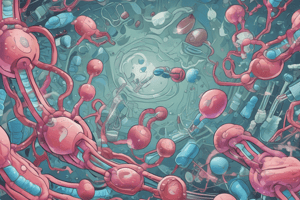Podcast
Questions and Answers
What is the primary mechanism of resistance to sulfa drugs in bacteria that obtain folate from their environment?
What is the primary mechanism of resistance to sulfa drugs in bacteria that obtain folate from their environment?
- Enhanced production of the natural substrate, PABA
- Altered dihydropteroate synthetase
- Decreased cellular permeability to sulfa drugs
- Naturally resistant due to environmental folate (correct)
What is the preferred treatment for toxoplasmosis?
What is the preferred treatment for toxoplasmosis?
- Sulfasalazine alone
- Pyrimethamine alone
- Sulfadiazine alone
- Sulfadiazine in combination with pyrimethamine (correct)
Why is sulfasalazine not absorbed when administered orally or as a suppository?
Why is sulfasalazine not absorbed when administered orally or as a suppository?
- It is broken down by intestinal flora (correct)
- It is not absorbed due to its molecular structure
- It is not absorbed due to its high molecular weight
- It is not absorbed due to its low solubility
What is the consequence of absorption of sulfapyridine in patients who are slow acetylators?
What is the consequence of absorption of sulfapyridine in patients who are slow acetylators?
In which patients are intravenous sulfonamides generally reserved for?
In which patients are intravenous sulfonamides generally reserved for?
What is the effect of resistance to one member of the sulfa drug family?
What is the effect of resistance to one member of the sulfa drug family?
What led to the development of numerous compounds utilized in clinical practice?
What led to the development of numerous compounds utilized in clinical practice?
What was the result of the continued modification of the quinolone nucleus?
What was the result of the continued modification of the quinolone nucleus?
What was the consequence of the overuse of quinolone antimicrobials?
What was the consequence of the overuse of quinolone antimicrobials?
What is the current status of quinolone antimicrobials?
What is the current status of quinolone antimicrobials?
What was synthesized in the early 1960s?
What was synthesized in the early 1960s?
What is the title of the chapter that discusses fluoroquinolone, folate antagonists, sulfonamides, trimethoprim, cotrimoxazole, and urinary tract antiseptics/antimicrobials?
What is the title of the chapter that discusses fluoroquinolone, folate antagonists, sulfonamides, trimethoprim, cotrimoxazole, and urinary tract antiseptics/antimicrobials?
What is a common adverse effect of fluoroquinolones that leads to discontinuation?
What is a common adverse effect of fluoroquinolones that leads to discontinuation?
What is a boxed warning associated with fluoroquinolones?
What is a boxed warning associated with fluoroquinolones?
What is the primary mechanism of action of methenamine in acidic urine?
What is the primary mechanism of action of methenamine in acidic urine?
Why should patients taking fluoroquinolones avoid excessive exposure to ultraviolet light?
Why should patients taking fluoroquinolones avoid excessive exposure to ultraviolet light?
What is the primary use of methenamine in UTI treatment?
What is the primary use of methenamine in UTI treatment?
Why is it necessary to maintain urine acidity when using methenamine?
Why is it necessary to maintain urine acidity when using methenamine?
In which population should the use of fluoroquinolones be limited to distinct clinical scenarios?
In which population should the use of fluoroquinolones be limited to distinct clinical scenarios?
Which of the following organisms is methenamine active against?
Which of the following organisms is methenamine active against?
What effect can fluoroquinolones have on the QTc interval?
What effect can fluoroquinolones have on the QTc interval?
What effect can ciprofloxacin have on the metabolism of certain medications?
What effect can ciprofloxacin have on the metabolism of certain medications?
What is the benefit of using methenamine in UTI treatment?
What is the benefit of using methenamine in UTI treatment?
What is the effect of gastric juices on methenamine?
What is the effect of gastric juices on methenamine?
Which mechanism does methenamine use to reach the urine?
Which mechanism does methenamine use to reach the urine?
What is the major adverse effect of methenamine?
What is the major adverse effect of methenamine?
Why is methenamine mandelate contraindicated in patients with renal insufficiency?
Why is methenamine mandelate contraindicated in patients with renal insufficiency?
What is the reason for not using sulfonamides concomitantly with methenamine?
What is the reason for not using sulfonamides concomitantly with methenamine?
What is the mechanism of action of nitrofurantoin?
What is the mechanism of action of nitrofurantoin?
What percentage of nitrofurantoin is excreted unchanged in the urine?
What percentage of nitrofurantoin is excreted unchanged in the urine?
What is the primary reason for combining trimethoprim with sulfamethoxazole in cotrimoxazole?
What is the primary reason for combining trimethoprim with sulfamethoxazole in cotrimoxazole?
Which step in the synthesis of tetrahydrofolic acid is inhibited by sulfamethoxazole?
Which step in the synthesis of tetrahydrofolic acid is inhibited by sulfamethoxazole?
What is the primary mechanism of action of cotrimoxazole?
What is the primary mechanism of action of cotrimoxazole?
What is the drug of choice for infections caused by susceptible Nocardia spp.?
What is the drug of choice for infections caused by susceptible Nocardia spp.?
What is the advantage of using cotrimoxazole over sulfonamides alone?
What is the advantage of using cotrimoxazole over sulfonamides alone?
Which of the following infections is cotrimoxazole effective in treating?
Which of the following infections is cotrimoxazole effective in treating?
What is the mechanism of action of trimethoprim in cotrimoxazole?
What is the mechanism of action of trimethoprim in cotrimoxazole?
Which of the following bacteria is cotrimoxazole active against?
Which of the following bacteria is cotrimoxazole active against?
What is the primary advantage of using cotrimoxazole over other antimicrobial agents?
What is the primary advantage of using cotrimoxazole over other antimicrobial agents?
What is the significance of the synergistic activity of cotrimoxazole?
What is the significance of the synergistic activity of cotrimoxazole?
Flashcards are hidden until you start studying
Study Notes
Sulfonamides
- Common organisms include Enterobacteriaceae, Haemophilus influenzae, Streptococcus spp., Staphylococcus spp., and Nocardia
- Sulfonamides are effective against these organisms
- Bacteria that obtain folate from their environment are naturally resistant to sulfa drugs
- Acquired bacterial resistance to sulfa drugs can arise from plasmid transfers or random mutations
- Resistance may be due to:
- Altered dihydropteroate synthetase
- Decreased cellular permeability to sulfa drugs
- Enhanced production of the natural substrate, PABA
- Organisms resistant to one member of this drug family are resistant to all
Sulfonamides Pharmacokinetics
- Most sulfa drugs are well absorbed following oral administration
- Sulfasalazine is not absorbed when administered orally or as a suppository and is reserved for the treatment of chronic inflammatory bowel diseases
- Intestinal flora split sulfasalazine into sulfapyridine and 5-aminosalicylate, with the latter exerting the anti-inflammatory effect
- Absorption of sulfapyridine can lead to toxicity in patients who are slow acetylators
- Intravenous sulfonamides are generally reserved for patients who are unable to take oral preparations or have severe infections
Urinary Tract Antiseptics/Antimicrobials
Methenamine
- Mechanism of action: Methenamine salts are hydrolyzed to ammonia and formaldehyde in acidic urine (pH ≤ 5.5)
- Antibacterial spectrum: Methenamine is active against E. coli, Enterococcus spp., and Staphylococcus spp.
- Pharmacokinetics: Methenamine is orally absorbed, with up to 30% decomposing in gastric juices, unless protected by enteric coating
Nitrofurantoin
- Introduced into clinical practice for the management of cystitis in the early 1950s
- Works by inhibiting DNA and RNA synthesis
- Susceptible organisms include E. coli, Klebsiella spp., Enterococcus spp., and Staphylococcus spp.
- Common adverse effects leading to discontinuation are nausea, vomiting, headache, and dizziness
- Carries boxed warnings for tendinitis, tendon rupture, peripheral neuropathy, and CNS effects (hallucinations, anxiety, insomnia, confusion, and seizures)
Fluoroquinolones
- Discovery led to the development of numerous compounds utilized in clinical practice
- Modifications of the quinolone nucleus expanded the spectrum of activity, improved pharmacokinetics, and stabilized compounds against common mechanisms of resistance
- Unfortunately, overuse resulted in rising rates of resistance in gram-negative and gram-positive organisms, increased frequency of Clostridium difficile infections, and identification of numerous untoward adverse effects
- Consequently, these agents have been relegated to second-line options for various indications
Fluoroquinolone Pharmacokinetics
- Binding to plasma proteins ranges from 20% to 84%
- Distributes well into all tissues and body fluids
- Concentrations are high in bone, urine (except moxifloxacin), kidney, prostatic tissue (but not prostatic fluid), and lungs as compared to serum
- Penetration into cerebrospinal fluid is good, and these agents may be considered in certain central nervous system (CNS) infections
- Accumulation in macrophages and polymorphonuclear leukocytes results in activity against intracellular organisms such as Listeria, Chlamydia, and Mycobacterium
- Most fluoroquinolones are excreted renally; dosage adjustments are needed in renal dysfunction
- Moxifloxacin is metabolized primarily by the liver, and while there is some renal excretion, no dose adjustment is required for renal impairment
Fluoroquinolone Adverse Reactions
- Common adverse effects leading to discontinuation are nausea, vomiting, headache, and dizziness
- Carry boxed warnings for tendinitis, tendon rupture, peripheral neuropathy, and CNS effects (hallucinations, anxiety, insomnia, confusion, and seizures)
- Patients taking fluoroquinolones are at risk for phototoxicity resulting in exaggerated sunburn reactions
- Patients should use sunscreen and avoid excessive exposure to ultraviolet (UV) light
Studying That Suits You
Use AI to generate personalized quizzes and flashcards to suit your learning preferences.




